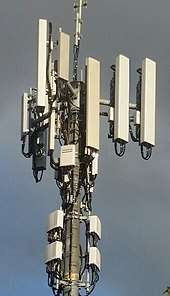Antenna efficiency
| Part of a series on |
| Antennas |
|---|
 |
|
Common types |
|
Radiation sources / regions |
In antenna theory, antenna efficiency is most often used to mean radiation efficiency. In the context of antennas, one often just speaks of "efficiency." It is a measure of the electrical efficiency with which a radio antenna converts the radio-frequency power accepted at its terminals into radiated power. Likewise, in a receiving antenna it describes the proportion of the radio wave's power intercepted by the antenna which is actually delivered as an electrical signal. It is not to be confused with aperture efficiency which applies to aperture antennas such as the parabolic reflector.
Definition
Radiation efficiency is defined by IEEE Std 145-1993[1] "Standard Definitions of Terms for Antennas" as "The ratio of the total power radiated by an antenna to the net power accepted by the antenna from the connected transmitter." It is sometimes expressed as a percentage (less than 100), and is frequency dependent. It can also be described in decibels.
For wire antennas which have a defined radiation resistance the radiation efficiency is the ratio of the radiation resistance to the total resistance of the antenna including ground loss (see below) and conductor resistance. [2] In practical cases the resistive loss in any tuning and/or matching network is often included, although network loss is strictly not a property of the antenna.
For other types of antenna the radiation efficiency is less easy to calculate and is usually determined by measurements.
The gain of an antenna is the directivity multiplied by the radiation efficiency, as described in Std 145-1993.
Ground loss
For monopole and other ground-based antennas, ground loss occurs due to ohmic resistance in the antenna's connection to its ground plane/counterpoise, including its mast or stalk and its bonding connections, as well as the ohmic resistance encountered by radio-frequency currents in the ground plane in the vicinity of the antenna.
Aperture efficiency
This is a distinct concept applied to aperture antennas such as a parabolic antenna and is a measure of the reduction in power gain caused by non-uniform aperture illumination by the feed antenna. In a typical situation the reflector is illuminated with a reduced power-density at the edge compared with the centre, in order to reduce sidelobes and other effects. This causes a reduction in gain: the ratio of the gain of the tapered aperture distribution to the theoretical gain of a uniformly illuminated aperture is the aperture efficiency. [3]
References
- ↑ IEEE Std 145-1993, Standard Definitions of Terms for Antennas, ISBN 1-55937-317-2, IEEEXplore
- ↑ Weelkes, W.J, (1968), Antenna Engineering, McGraw Hill Book Company, p. 29
- ↑ Weelkes, W.J, (1968), Antenna Engineering, McGraw Hill Book Company, pp. 256-258